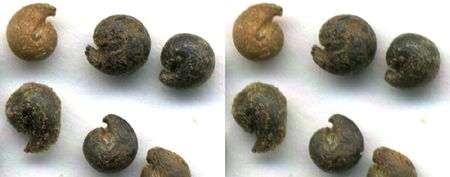Cleome
Cleome is a genus of flowering plants in the family Cleomaceae, commonly known as spider flowers, spider plants, spider weeds, or bee plants.[2][3] Previously, it had been placed in the family Capparaceae, until DNA studies found the Cleomaceae genera to be more closely related to the Brassicaceae than the Capparaceae. Cleome and clammyweed, (Polanisia dodecandra) can sometimes be confused. The simplest way to differentiate the two is to compare the seedpods which project out or down on cleome and up on clammyweed.
| Cleome | |
|---|---|
_in_Gavi.jpg) | |
| Cleome hassleriana | |
| Scientific classification | |
| Kingdom: | Plantae |
| Clade: | Tracheophytes |
| Clade: | Angiosperms |
| Clade: | Eudicots |
| Clade: | Rosids |
| Order: | Brassicales |
| Family: | Cleomaceae |
| Genus: | Cleome L. |
| Synonyms[1] | |
|
List
| |
The genus sensu stricto includes about 170 species of herbaceous annual or perennial plants and shrubs.[4] The genus has a subcosmopolitan distribution throughout the tropical and warm temperate regions of the world.[4] However, a recent DNA study failed to separate Cleome, Podandrogyne, and Polanisia from each other, so some taxonomists have abandoned the last two of these genera, treating them as part of Cleome sensu lato; in this case, Cleome contains about 275 species, the vast majority of the Cleomaceae.
The genus contains species which show an evolutionary progression from C3 to C4 photosynthesis. This, combined with it being very close to the Brassicaceae with the model plant species Arabidopsis thaliana, makes it an ideal genus in which to study the evolution of C4 photosynthesis. Morphological differences that demonstrate the transition from C3 to C4 include C3 species having leaves with more veins and larger bundle sheath cells. Also, species such as Cleome gynandra produce proteins needed for C4 photosynthesis.[5] Three species independently acquired the C4 pathway, while others are C3–C4 intermediate or C4-like.[6]
Selected species
- Cleome aculeata L., tropical
- Cleome angustifolia Forssk.; African – C4
- Cleome anomala Kunth; neotropical
- Cleome arborea Kunth
- Cleome arenitensis Craven, Lepschi & Fryxell
- Cleome aspera Koen. ex DC.
- Cleome augustinensis (Hochr.) Briq.
- cleome ciliata D.Dian
- Cleome chilensis DC.
- Cleome cleomoides (F.Muell.) Iltis
- Cleome cordobensis Eichler ex Griseb.
- Cleome diffusa Banks ex DC.
- Cleome eosina J.F.Macbr.
- Cleome felina L.f.
- Cleome flexuosa F.Dietr.
- Cleome foliosa Hook.f.
- Cleome gigantea L.
- Cleome glabra Taub. ex Glaz.
- Cleome guianensis Aubl.
- Cleome gynandra L. – C4
- Cleome hassleriana Chodat
- Cleome herrerae J.F.Macbr.
- Cleome hirta (Klotzsch) Oliv.
- Cleome iberica DC.
- Cleome isomeris Greene
- Cleome kenneallyi Hewson
- Cleome lanceolata (Mart. & Zucc.) H.H.Iltis
- Cleome lechleri Eichler
- Cleome lutea Hook.
- Cleome maculata (Sond.) Szyszył.
- Cleome micrantha Desv. ex Ham.
- Cleome monophylla L.
- Cleome multicaulis DC.
- Cleome ornithopodioides L.
- Cleome oxalidea F.Muell. – C4
- Cleome paludosa Willd. ex Eichler
- Cleome parviflora Kunth
- Cleome pilosa
- Cleome platycarpa Torr.
- Cleome psoraleifolia DC.
- Cleome rubella Burch.
- Cleome rutidosperma DC.
- Cleome serrata Jacq.
- Cleome serrulata Pursh
- Cleome sparsifolia S.Wats.
- Cleome speciosa Raf.
- Cleome spinosa Jacq.
- Cleome stenophylla Klotzsch ex Urban
- Cleome stylosa Eichler
- Cleome tetrandra DC.
- Cleome titubans Speg.
- Cleome trachycarpa Klotzsch ex Eichler
- Cleome tucumanensis H.H.Iltis
- Cleome uncifera Kers
- Cleome violacea L.
- Cleome viridiflora Schreb.
- Cleome viscosa L.
- Cleome werdermannii A. Ernst
- Cleome monophylla
Cultivation and uses
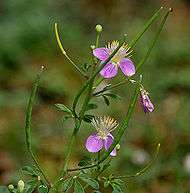
Cleome gynandra is used as a vegetable crop. C. hassleriana is a commonly cultivated ornamental plant with purple, pink, or white flowers.
Gallery of species
| ||
| ||
| ||
| ||
| ||
| Cleome seeds resemble snail shells |
 Cleome chelidonii
Cleome chelidonii- Cleome foliosa, from arid region in Namibia
 Cleome gynandra, cultivated as a vegetable
Cleome gynandra, cultivated as a vegetable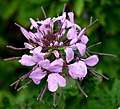 Cleome 'Inncleosr' Senorita Rosalita
Cleome 'Inncleosr' Senorita Rosalita Cleome hassleriana[11] a common garden ornamental
Cleome hassleriana[11] a common garden ornamental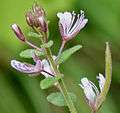 Cleome monophylla
Cleome monophylla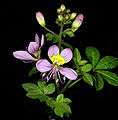 Cleome oxyphylla
Cleome oxyphylla
 Cleome spinosa
Cleome spinosa
References
- "Cleome L." Plants of the World Online. Board of Trustees of the Royal Botanic Gardens, Kew. 2017. Retrieved 13 July 2020.
- Steve L. O’Kane, Jr. "Cleomaceae: Cleome Family". San Juan College. Archived from the original on October 5, 2011. Retrieved July 29, 2011.
- G. J. H. Grubben (2004). Plant Resources of Tropical Africa 2: Vegetables. PROTA. p. 197–198. ISBN 978-90-5782-147-9.
- Huxley, A., ed. (1992). New RHS Dictionary of Gardening 1: 652-653. Macmillan. ISBN 1-56159-001-0.
- Marshall, D.M.; Muhaidat, R.; Brown, N.J.; Liu, Z.; Stanley, S.; Griffiths, H.; Sage, R.F.; Hibberd, J.M. (2007). "Cleome, a genus closely related to Arabidopsis, contains species spanning a developmental progression from C3 to C4 photosynthesis". The Plant Journal. 51 (5): 886–896. doi:10.1111/j.1365-313X.2007.03188.x. ISSN 0960-7412.

- Feodorova, T.A.; Voznesenskaya, E.V.; Edwards, G.E.; Roalson, E.H. (2010). "Biogeographic patterns of diversification and the origins of C4 in Cleome (Cleomaceae)" (PDF). Systematic Botany. 35 (4): 811–826. doi:10.1600/036364410X539880. ISSN 0363-6445. Retrieved 16 June 2016.
- Germplasm Resources Information Network: Cleome list Archived 2009-01-20 at the Wayback Machine
- Flora Europaea: Cleome list
- USDA Plants Profile: Cleome list
- Efloras: Cleome search results
- Flora of China 7: 430–431. 2008: Tarenaya Rafinesque
